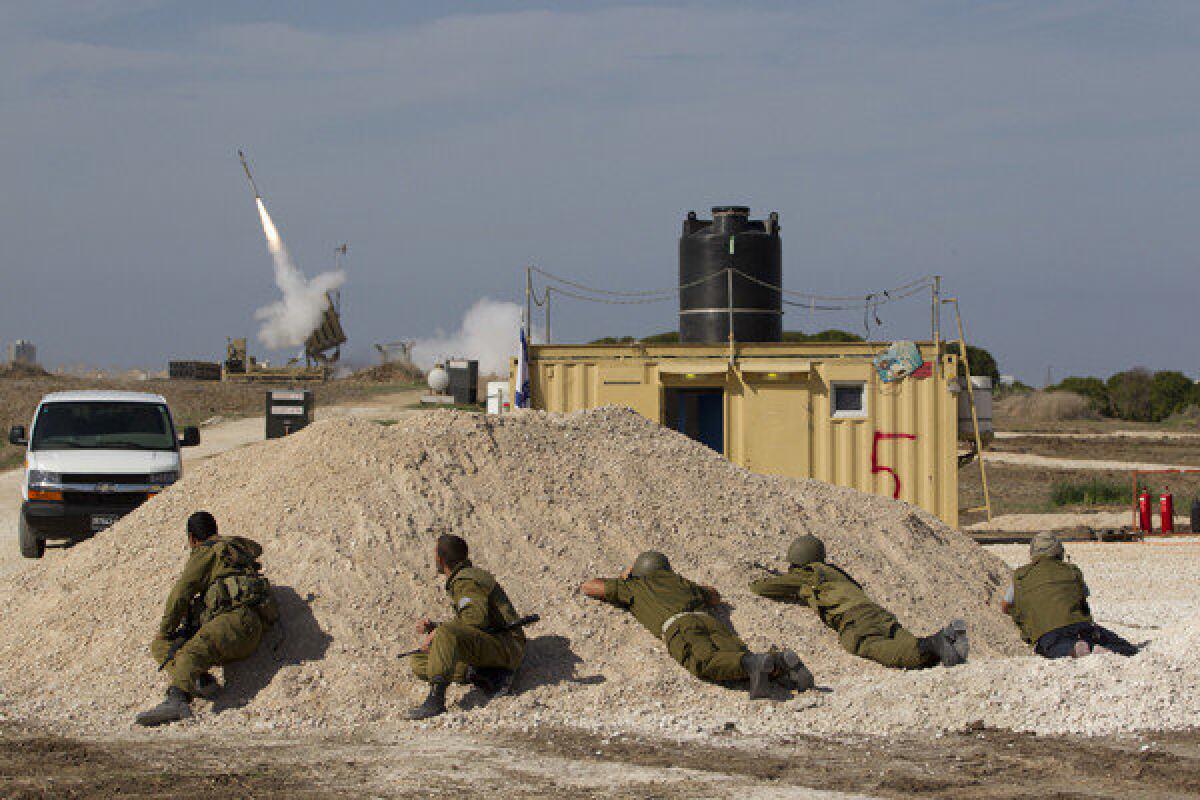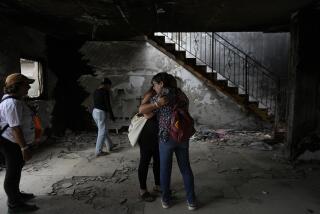Israel’s Iron Dome missile defense drawing praise

- Share via
ASHDOD, Israel — School is out in this coastal city, Israel’s fifth-most populous, but the playgrounds are empty. Most shops in the Sea Mall shopping center are closed.
Halfway between Gaza City and Tel Aviv, Ashdod has been the target of rockets from the Gaza Strip during several days of hostilities between Israel and Hamas, the militant group that controls the strip. Between air raid sirens, citizens try to maintain some sense of normality, while staying within running distance of shelter.
Few people venture out unnecessarily.
TIMELINE: Israel-Gaza conflict
But Omer Binyamin was sitting on the stairs outside the bank downtown the other day, a cigarette in one hand, his bank statement in the other.
“No way I’d be sitting out here in the open if it weren’t for Iron Dome,” said Binyamin, 32, a truck driver.
He was referring to the Israeli air defense system. Iron Dome has shown about an 85% success rate in stopping rockets deemed to pose a threat to life or property during the last six days, Israeli officials say. The system is widely credited in Israel with having minimized casualties.
Israeli Defense Minister Ehud Barak gushed this week about what he termed the “unprecedented” success of the anti-rocket system during a ceremony marking the installation of a fifth Iron Dome battery, this one in the Tel Aviv area. Within several years, Barak said, Israel plans “to cover the whole country, all around, against a much wider range of threats.”
Hours after it was installed, the Tel Aviv battery was credited with downing two rockets streaking toward the city.
But the system has not been flawless of late, despite the public accolades.
Authorities this week disclosed that an Iron Dome malfunction probably contributed to a rocket strike on an apartment complex in the town of Kiryat Malachi. Three people, including a pregnant woman, died in the attack, the most significant Israeli casualties of the violence.
Israeli press reports indicate that the Iron Dome installation in Kiryat Malachi suffered a communications problem. There have also been reports of shrapnel damage on the ground from the remains of Israeli interceptor missiles.
U.S. taxpayers have paid much of the reported $500-million price tag — to date — of Iron Dome, which Israel began developing five years ago. The U.S. ambassador here, Dan Shapiro, appeared with the Israeli defense minister in the ceremony installing the latest battery.
U.S. funding is also expected to underwrite Israeli’s next-generation antimissile shield, known as David’s Sling, aimed at longer-range missiles, fired from as far away as Iran. Rafael Advanced Defense Systems, the Israeli firm that developed Iron Dome, is also working on David’s Sling, along with Raytheon, the U.S. defense giant. Rafael would like to market Iron Dome globally.
The system is a dome in name only: It relies on missiles to destroy warheads in midair.
Among Iron Dome’s signature attributes is a computerized radar and tracking system that monitors the trajectory of incoming rockets and shells, calculating where the munitions are likely to land. Projectiles headed for unpopulated areas where there would be little material damage are allowed to proceed. The purpose of Iron Dome is to intercept only those rockets deemed to pose a threat to life or property.
The system also is designed to detonate targeted warheads over open areas, reducing the possibility of injuries on the ground.
Officials say more than 1,000 rockets have been fired from Gaza during the last week.
When Iron Dome was first proposed, the concept met considerable doubt. Skeptics worried that it would be ineffective, expensive and incapable of meeting the mounting threat of ever more and ever longer-range missiles in the stockpiles of Israel’s enemies, including Hamas in Gaza, Hezbollah in Lebanon and the government of Iran. The reported $50,000 each missile would cost seemed high when aggressors were known to possess tens of thousands of mostly inexpensive rockets that could reach Israeli territory.
But in places like Ashdod and other southern towns where the expanding range and numbers of Palestinian rockets are a genuine threat, the system has seemed invaluable.
“It’s very frightening — these rockets are no joke; they kill people,” Binyamin said.
At a small cafe, a few men sat around tables. Yehudah Arie contemplated a crossword puzzle.
“I hope the government is determined enough to put an end to this once and for all,” said Arie, adding that “you can’t keep half the country in bomb shelters forever.”
In midsentence, an air raid siren sounded . “You see what kind of place we live in?” Arie said.
“It’s the fourth this morning,” he said, ushering everyone nearby to a designated safe space, wedged between a drugstore and a real estate agency in a building next door.
A thud was heard just as an elderly woman walked in.
“They won’t reach us here?” she asked.
Sobelman is a news assistant in The Times’ Jerusalem bureau.
More to Read
Sign up for Essential California
The most important California stories and recommendations in your inbox every morning.
You may occasionally receive promotional content from the Los Angeles Times.










